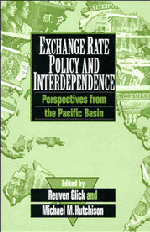Book contents
- Frontmatter
- Contents
- List of contributors
- Preface
- Exchange rate policy and interdependence
- 1 Overview
- I International financial market integration
- 2 Financial links around the Pacific Rim: 1982–1992
- 3 Relative returns on equities in Pacific Basin countries
- 4 Exchange rate policy, international capital mobility, and monetary policy instruments
- II Choice of exchange rate regimes
- III Intervention and sterilization policies
- IV Prospects for a yen bloc
- Index
2 - Financial links around the Pacific Rim: 1982–1992
Published online by Cambridge University Press: 04 May 2010
- Frontmatter
- Contents
- List of contributors
- Preface
- Exchange rate policy and interdependence
- 1 Overview
- I International financial market integration
- 2 Financial links around the Pacific Rim: 1982–1992
- 3 Relative returns on equities in Pacific Basin countries
- 4 Exchange rate policy, international capital mobility, and monetary policy instruments
- II Choice of exchange rate regimes
- III Intervention and sterilization policies
- IV Prospects for a yen bloc
- Index
Summary
Introduction
The rapid steps Europe has taken toward economic integration, and their many effects, have been extensively studied. There exists a belief that economic links among Pacific countries are also increasing rapidly, and a suspicion that Japan is at the root of it, but these issues have been less extensively studied. Some recent tests regarding bilateral trade suggest that there is not in fact an increasing bias toward intraregional trade within East Asia and that the Pacific–wide grouping which includes North America is the most natural “trade bloc.” But there are signs that Japanese financial influence is increasing in East Asia. Capital flows within the region, particularly foreign direct investment by Japan in Southeast Asia, are growing. The yen is playing a greater role in the region, as reflected in trade invoicing, loan denomination, reserve holdings, and exchange rate policies. The role of the dollar is still dominant, however.
This essay investigates the extent to which Pacific financial markets are becoming more tightly linked, by analyzing the co–movements of interest rates in a number of countries around the Pacific. International equalization of interest rates has a number of important policy implications. It would imply, for example, that national monetary authorities had lost the ability to affect domestic demand through independent monetary policies and that countries would be able to finance investments easily despite shortfalls of saving. Earlier studies of these issues in the Pacific context include Cheng (1988), Glick (1987), and Glick and Hutchison (1990).
- Type
- Chapter
- Information
- Exchange Rate Policy and InterdependencePerspectives from the Pacific Basin, pp. 17 - 47Publisher: Cambridge University PressPrint publication year: 1994
- 19
- Cited by



